- The Indianapolis Colts needed Jonathan Taylor: Taylor touched the ball 23 times per game, ranking second-most among all running backs last season.
- Can he return to 2021 form?: His efficiency has swiftly declined since his historic 2021 season, but he’s also dealt with injuries. It’s possible a healthy Taylor can return to form, but it’s also possible his efficiency will continue to decline.
- Subscribe to PFF+: Get access to player grades, PFF Premium Stats, fantasy football rankings, all of the PFF fantasy draft research tools and more!
Estimated Reading Time: 5 minutes

PFF’s Fantasy Football Player Profile series delivers the most in-depth fantasy football analysis available for the 2025 season.
Using PFF’s exclusive data, we evaluate player performance, competition for touches and how teammates and coaching staffs will impact each player's fantasy football outlook.
Last updated: 7:15 a.m. Tuesday, May 13
Player performance
Jonathan Taylor was the 41st overall selection of the 2020 NFL Draft. While he was the third running back off the board, many dynasty managers made the right decision in picking him over Clyde Edwards-Helaire and D’Andre Swift. The Colts eased him into action as a rookie with a 50% snap rate. In 2021, he was the clear best running back in the league. He led the league in rushing attempts, yards and touchdowns. He earned the most fantasy points and points per game regardless of league format, an Associated Press first-team All-Pro and was PFF’s highest graded running back. No other running back has ever accomplished all of that in the same season.
Taylor hasn’t been nearly as effective over the last three seasons. Taylor’s 73.7 rushing grade during the previous three years is tied for 43rd-best among the 49 running backs with 300 or more carries. The running backs tied with him or lower include Ezekiel Elliott, Jamaal Williams and Dalvin Cook, who are unsigned free agents, and Zack Moss, Rachaad White and Javonte Williams. The other three running backs below a 76.0 rushing grade are also expected to be backups this year.
Part of Taylor’s problem has been injury, where he’s missed at least three games in the last three years. He’s been listed with an ankle injury on the injury report in November 2020, October 2022, November 2022, October 2023 and October 2024. Throughout his career, he’s also been listed with a thumb, ankle, toe, ribs, knee and shoulder injuries.
Part of the reason he continues to see so many touches is his big-play ability. He’s received a +1 rushing grade or better at the 12th-highest rate among the 49 runners with 300 or more carries over the past three years. However, his rate of achieving +0.5 rushing grades is the fifth-lowest among those same backs. His ranks among running backs, specifically in 2024, were nearly identical. That played out in a big way with his statistics. He had three runs of 55-plus yards, which was the second most to Saquon Barkley. However, his rate of gaining at least three yards on a play was in the bottom 30% of all running backs, and most of the backs below him played behind worse offensive lines.
The Colts worked Taylor especially hard over the last five games of the season. He averaged 28.4 carries for 144.6 yards and 1.2 touchdowns, leading to 25.6 fantasy points per game over that stretch. He was averaging 14.2 fantasy points per game leading up to that point.
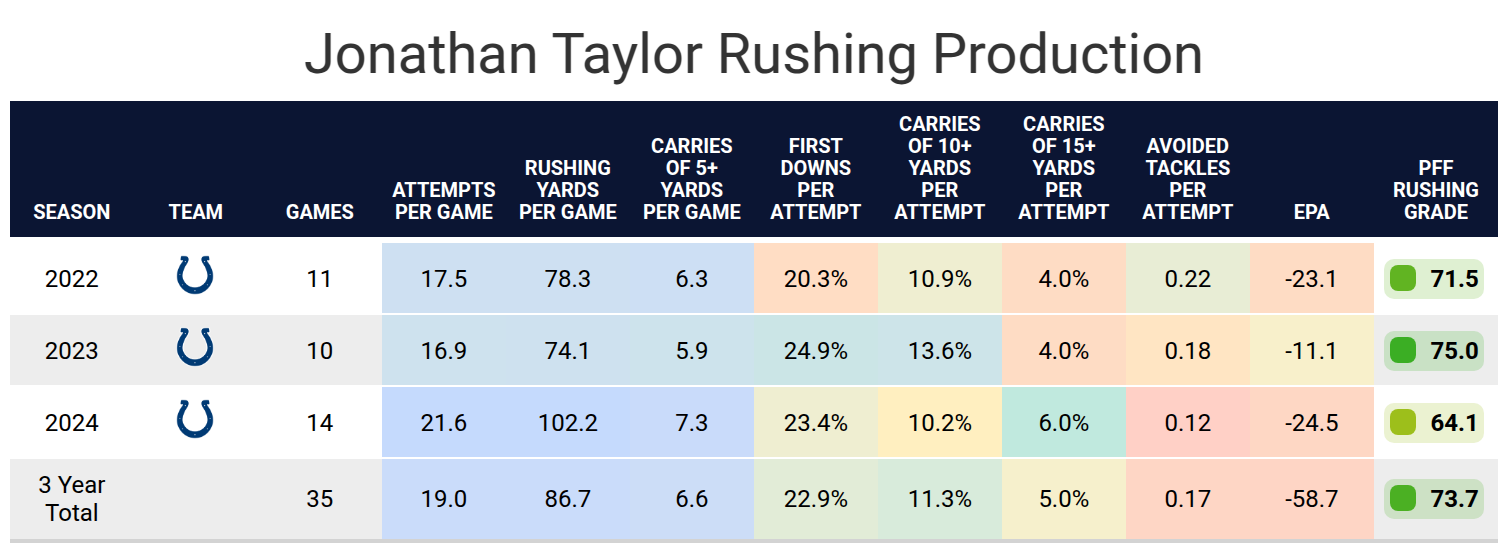
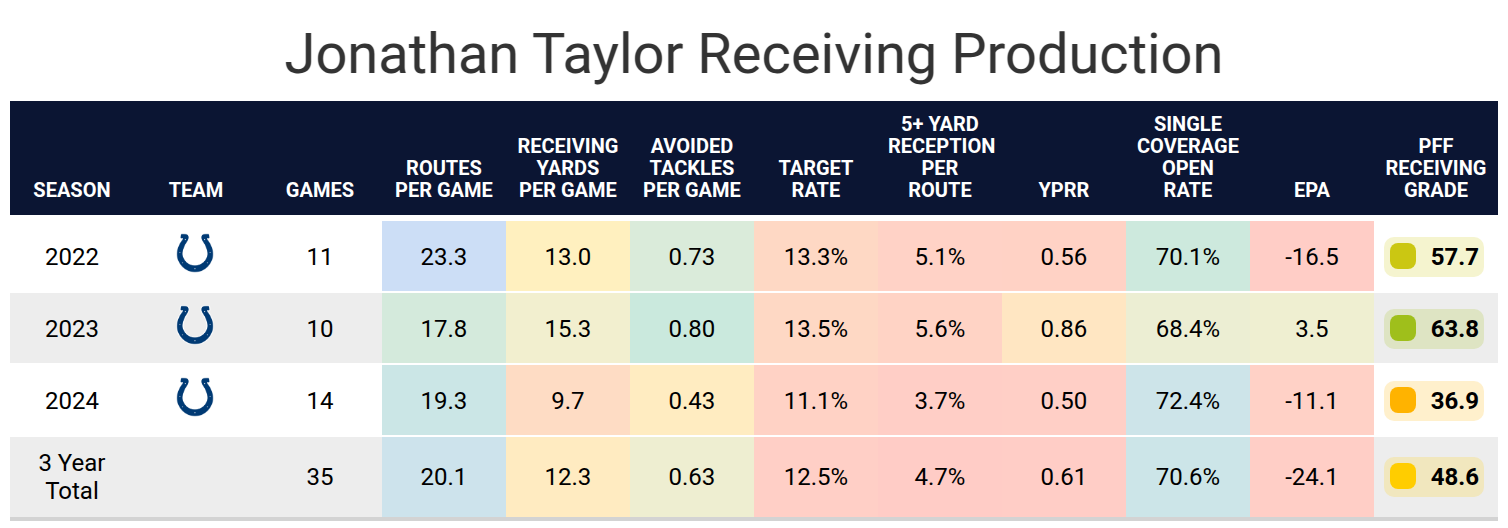
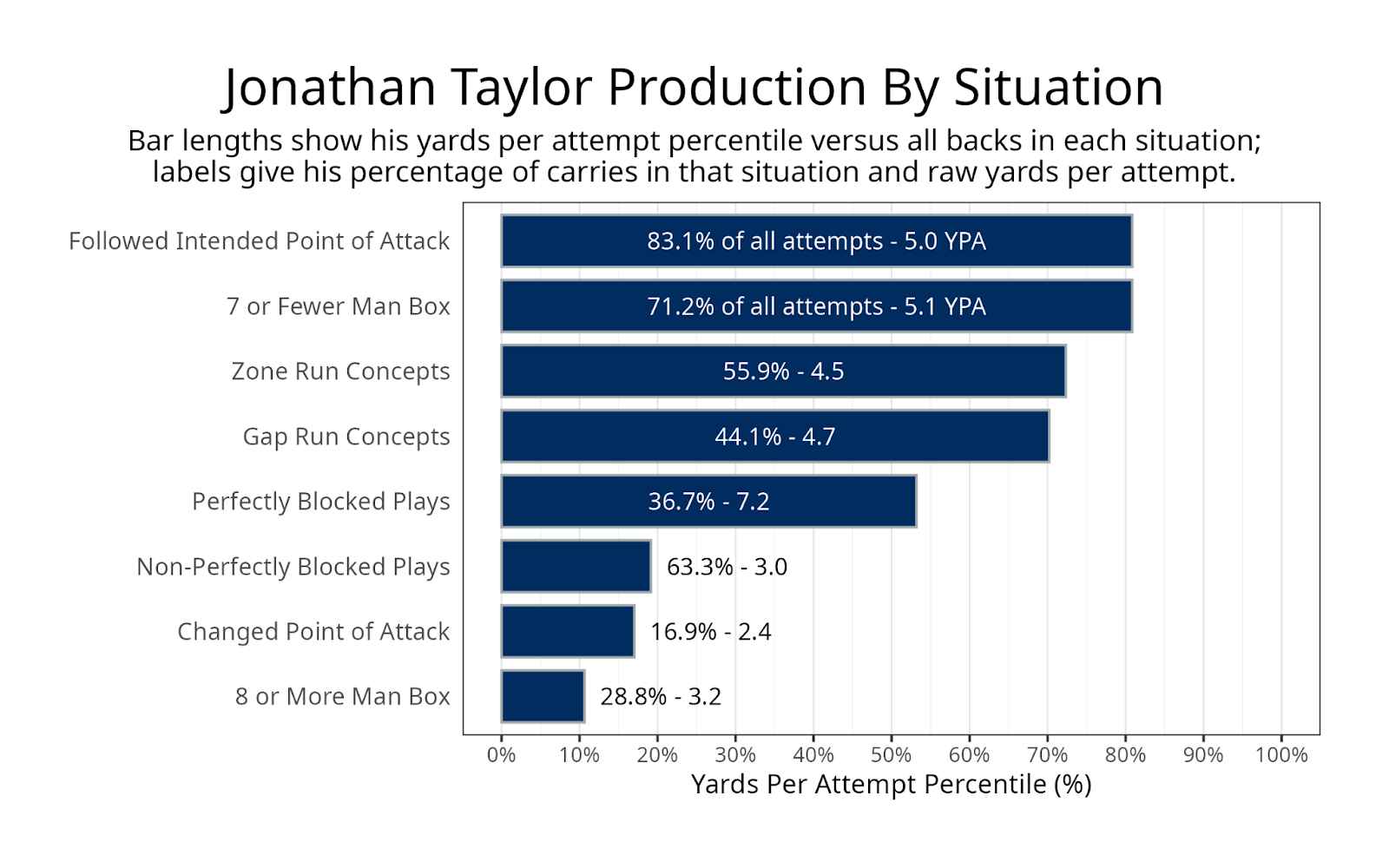
Projected role
Taylor’s role was larger last season than in other recent seasons, but the Colts brought in new backups for this season. They spent a fifth-round pick on D.J. Giddens and veteran free agent Khalil Herbert. All three running backs are best suited for early-down work rather than on third downs. While Taylor’s work in short-yardage situations and at the goal line should be safe, there is a solid chance that one of these running backs can cut into Taylor’s playing time on early downs.
An 88.7% snap rate is exceptionally high for a modern-day running back with an extensive injury history. The Colts appear fully committed to Taylor being the feature back, but he may lose some volume, which could also help his efficiency. Given Taylor’s injury history, it’s also possible one of these backs starts multiple games this season.
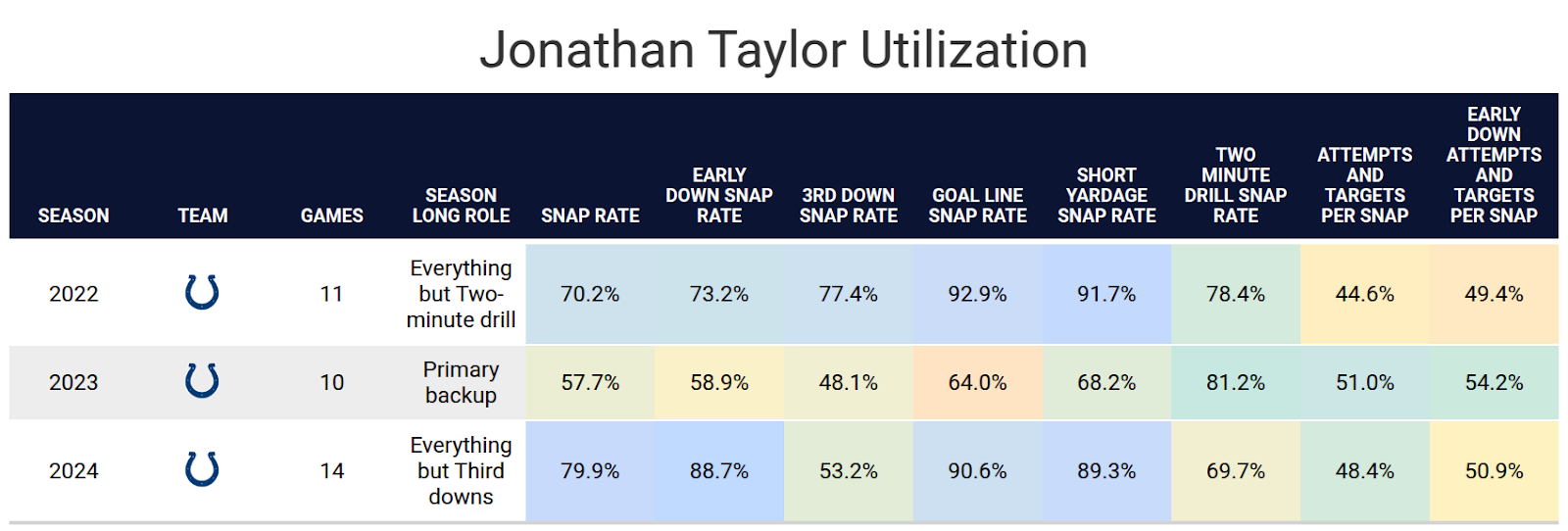
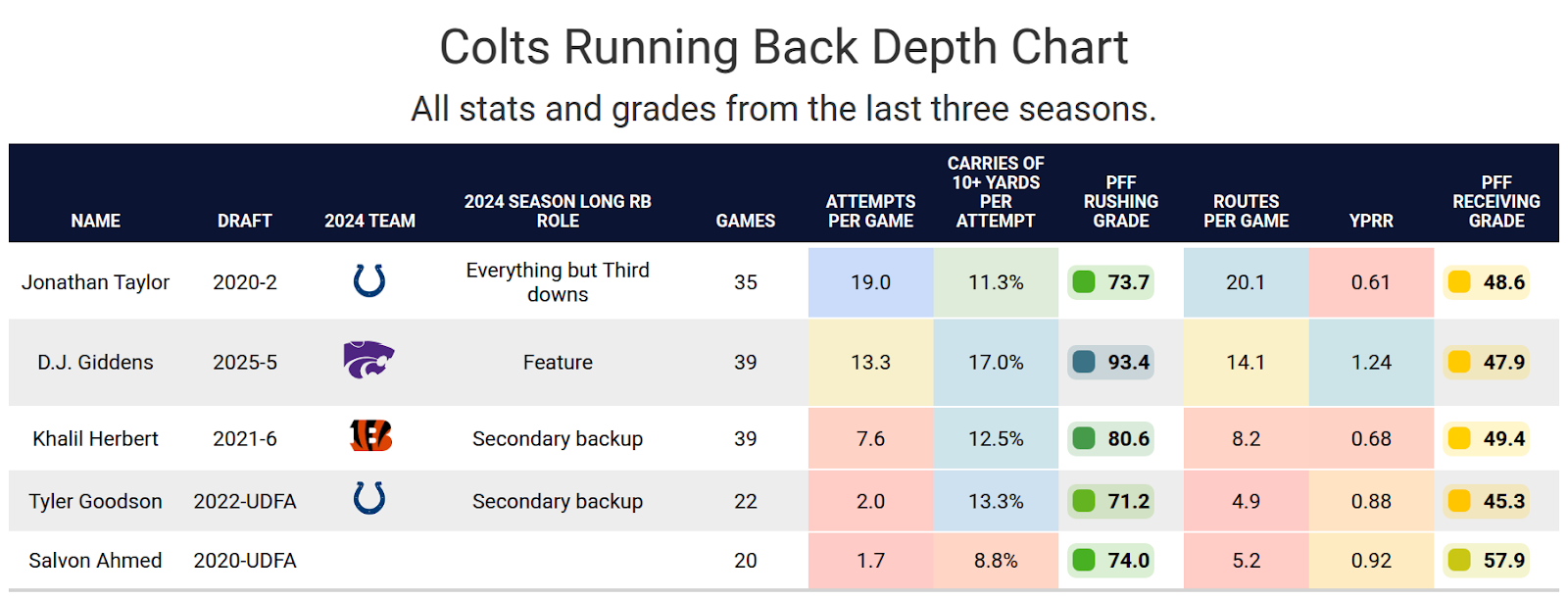
Impact of teammates
Taylor will be entering his third season with Shane Steichen as his head coach. Last year, his run rate skyrocketed, likely due to the quarterback play. This is largely what led to Taylor finishing second in touches per game among running backs last season. Part of Taylor’s fantasy success will depend on how much more the Colts trust their passing game. They will still be more run-heavy than the average team, but if they are a little less run-heavy this year, that will lead to fewer touches by Taylor.
The Colts' offensive line was a big reason why Taylor’s yards per attempt numbers improved, while other rate stats that are more closely tied to Taylor went down. Bernhard Raimann and Quenton Nelson have been the left side of the Colts' offensive line for the past three years, and both had their best seasons during that stretch, finishing with run-blocking grades in the 80.0s. Right tackle Braden Smith has earned an 86.0-plus run-blocking grade in three of the last six seasons. The Colts went through several players at center, right guard and tackle when players were injured last year. Both Tanor Bortolini and Matt Goncalves played well for mid-round rookies in their limited starts. If the two young players can take another step forward, the Colts could have one of the best lines in the NFL.

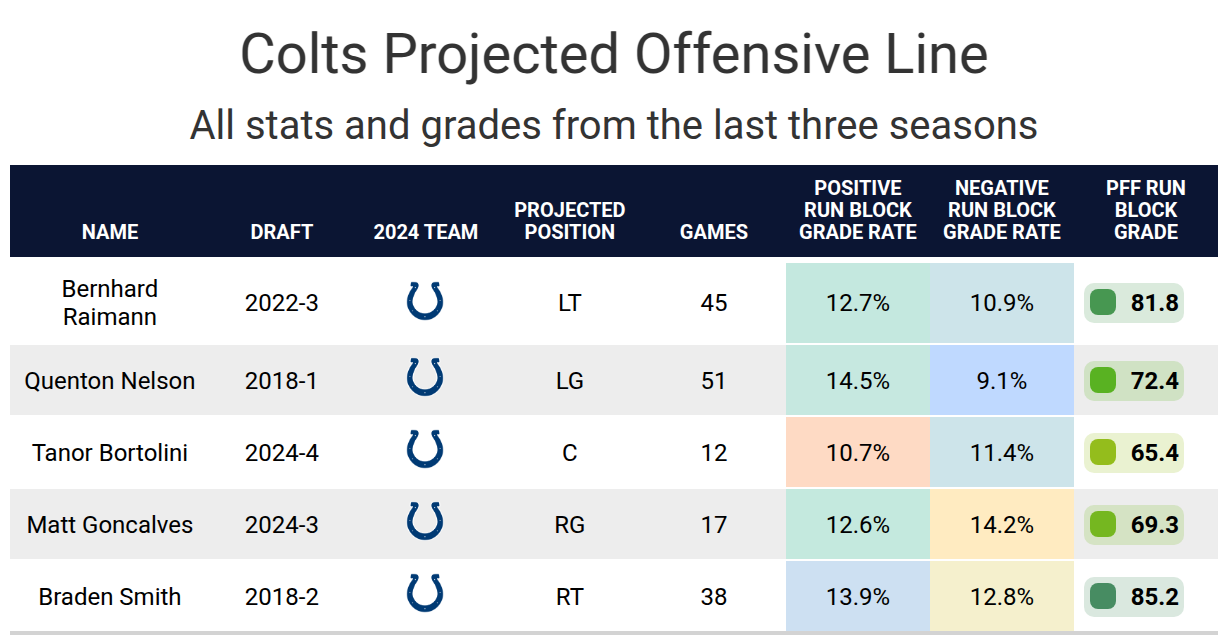
Bottom line
Taylor has mixed high volume with inefficient play. Usually, this is the recipe for a big decline in fantasy production. However, Taylor has a high rate of big plays, the trust of the coaching staff, and an excellent 2021 season, so there is always a chance he returns to that form. Taylor is a fine top-15 fantasy option, with a decent chance to finish in the top 10, and an outside chance to return to the league’s elite.

Footnotes
- Statistics in tables and charts were chosen based on their ability to predict future fantasy performance on a per-game or per-opportunity basis or to describe the player relative to others at the same position.
- “Opportunities” are defined as passing dropbacks, rushing attempts and routes run as a receiver.
- Numbers are provided either by season or based on the past three years. For rookies, only college statistics are included. For non-rookies, only NFL statistics are considered, regardless of whether they played in college within the previous three years.
- As college competition is easier than NFL competition, most rookies are likely to see a decline from their historical numbers.
- Only FBS data is considered for college players and comparisons.
- Kneel-downs are removed from rushing data to provide cleaner quarterback rushing rate statistics.
- The table colors in this article range from blue (indicating good/high) to red (indicating bad/low).
- All percentiles and color codings compare the given player to others with a high sample of opportunities. Generally, the cutoff is one-third of the possible opportunities in the sample. If a player does not meet the threshold, they are still included in the comparison, though their results may appear better or worse than expected due to the smaller, less predictive sample size.
- Information on utilization classifications and their importance can be found here for running backs, wide receivers and tight ends.



 © 2025 PFF - all rights reserved.
© 2025 PFF - all rights reserved.